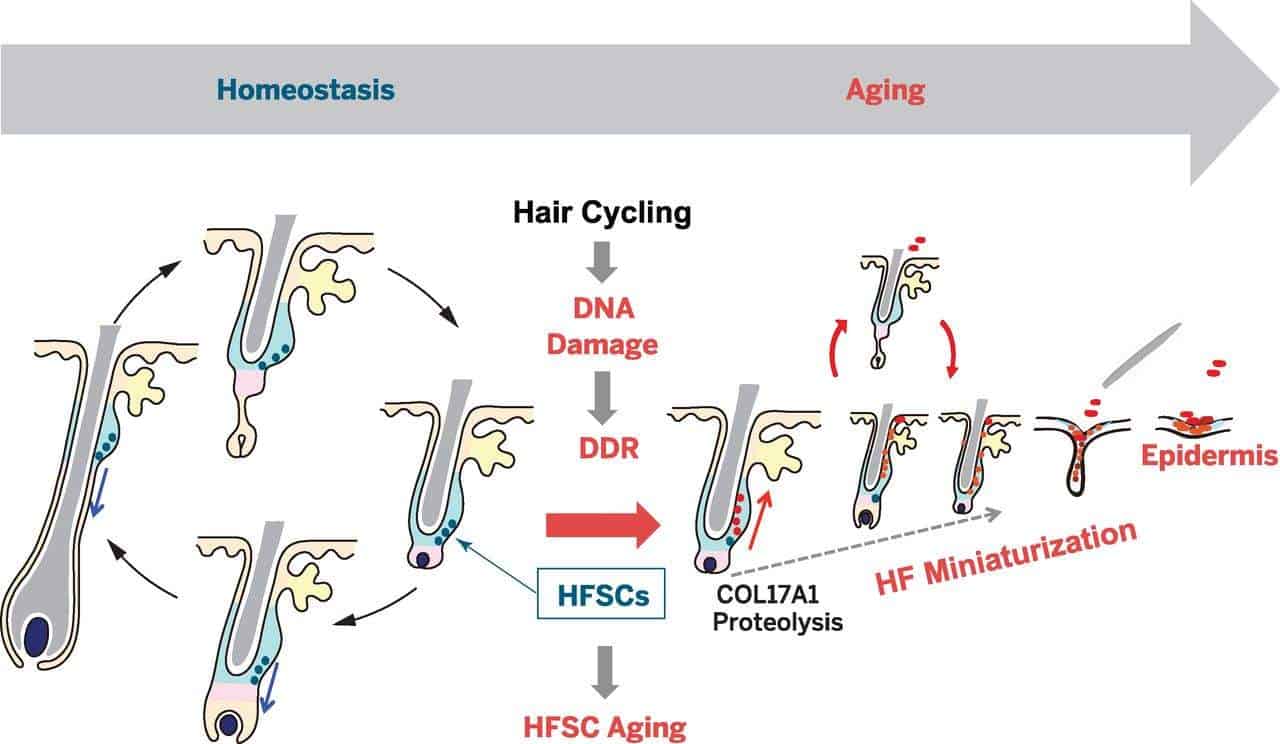And while one reason for hair loss can be fixed through specific behavioral changes, the other can lead the scientists to the ultimate anti-aging cure. One is connected with the degradation of stomach acid and the other is caused by the damaged DNA.
#1 – Deterioration of gastric juice acidity
Inadequate acidity of gastric juice (hypochlorhydria) is a known issue, that’s been connected with many health related problems so it’s strange why medical specialists are reluctant to order a diagnostic of acidity level in a stomach of the patient.
Acidity levels drop naturally as a result of aging, especially after the age of 40. It manifests primarily in loss of hair pigment and deterioration of skin quality.
Roseburg study[1], conducted in 2005, on 25 individuals diagnosed with hypochlorhydria, in age span from 17 to 80, showed significant improvements of gastric juice acidity at 66.7% of subjects. Subjects were digesting 1 liter of properly prepared green smoothy[i1] per day for a period of 30 days.
One specific change occurs with the increase of acidity: restoration of hair pigments after a period of consummation of blended green, leafy vegetables along with some added fruits and water. Dr. Ann Wigmore, pioneer of green smoothies and sprouting, was one of the first documented individuals who managed to successfully restore the pigmentation of her hair on account of “energy soup” and properly blended green smoothies.

#2 – Depletion of specific collagen type due to damaged DNA
In recent study, published on Science, team of researchers proved that specific type of collagen, COL17A1, is getting depleted through the process known as proteolysis: “DNA damage-induced depletion of COL17A1 triggered cell differentiation resulting in the shedding of epidermal keratinocytes from the skin surface. These changes then caused hair follicle shrinkage and hair loss.”
We know that organs are shrinking and hair is getting thinner until eventually, we start losing it. It happens at all long-living mammals on the planet. What we didn’t know is how it occurs. The study examined the process of degradation of follicle cell, a mini organ under the skin, responsible for hair growth. Hair loss is known sign of aging at some people.
The study has shown that hair follicle stem cell (HFSC) aging causes the stepwise miniaturization of hair follicles and eventual hair loss in wild-type mice and in humans.
It appears that aged hair follicle stem cells are getting removed which is causing the miniaturization of HC. Body eats away this specific type of collagen while not substituting it.
The conclusion made by scientists presents direction in which anti-aging researches may be heading:
“The aging process can be recapitulated by Col17a1 deficiency and prevented by the forced maintenance of COL17A1 in HFSCs, demonstrating that COL17A1 in HFSCs orchestrates the stem cell–centric aging program of the epithelial mini-organ.”
Unlike mere marketing efforts behind largely unproven benefits of adding the Q-10 in crèmes and lotions, this study may in fact pave the way for the groundbreaking progress where science will find the way to re-enforce the maintenance of COL17A1 and subsequently prevent hair thinning and loss.
We can only speculate in this point of how expensive this treatment will be in near future. So it’s perhaps a good investment tactic to follow on future advances in this field. Don’t forget that the largest number of these types of researches is funded by the large pharmaceutical companies. First who figure it out, will cash in billions on the final product.
[1] Roseburg study was conducted by Dr. Paul Fieber and Victoria Boutenko in 2005 where 25 individuals, diagnosed with hypochlorhydria, were taking 1 liter of prepared green smoothy per day for the period of 30 days in order to confirm possibility of natural restoration of adequate acidic levels of gastric juice. In the same time, subjects were asked not to alter their usual daily diet. Beside positive result in restoration of acidity levels, all subjects experienced other health and endurance related improvements. —get back to reading—








